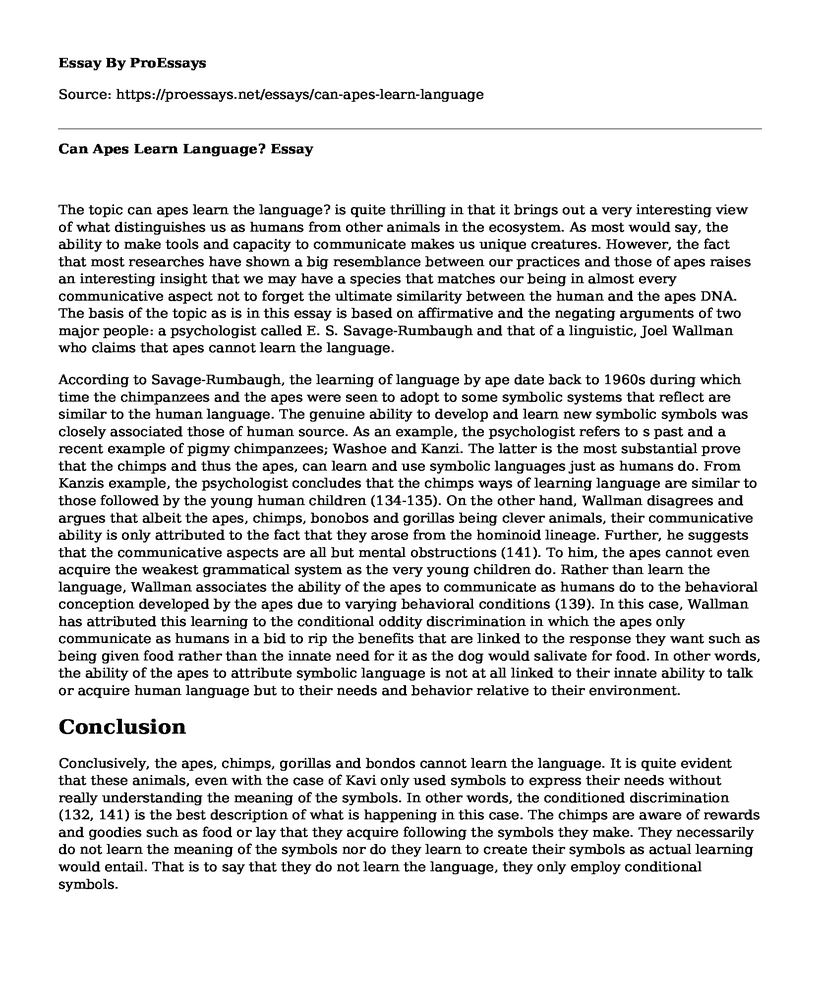The topic can apes learn the language? is quite thrilling in that it brings out a very interesting view of what distinguishes us as humans from other animals in the ecosystem. As most would say, the ability to make tools and capacity to communicate makes us unique creatures. However, the fact that most researches have shown a big resemblance between our practices and those of apes raises an interesting insight that we may have a species that matches our being in almost every communicative aspect not to forget the ultimate similarity between the human and the apes DNA. The basis of the topic as is in this essay is based on affirmative and the negating arguments of two major people: a psychologist called E. S. Savage-Rumbaugh and that of a linguistic, Joel Wallman who claims that apes cannot learn the language.
According to Savage-Rumbaugh, the learning of language by ape date back to 1960s during which time the chimpanzees and the apes were seen to adopt to some symbolic systems that reflect are similar to the human language. The genuine ability to develop and learn new symbolic symbols was closely associated those of human source. As an example, the psychologist refers to s past and a recent example of pigmy chimpanzees; Washoe and Kanzi. The latter is the most substantial prove that the chimps and thus the apes, can learn and use symbolic languages just as humans do. From Kanzis example, the psychologist concludes that the chimps ways of learning language are similar to those followed by the young human children (134-135). On the other hand, Wallman disagrees and argues that albeit the apes, chimps, bonobos and gorillas being clever animals, their communicative ability is only attributed to the fact that they arose from the hominoid lineage. Further, he suggests that the communicative aspects are all but mental obstructions (141). To him, the apes cannot even acquire the weakest grammatical system as the very young children do. Rather than learn the language, Wallman associates the ability of the apes to communicate as humans do to the behavioral conception developed by the apes due to varying behavioral conditions (139). In this case, Wallman has attributed this learning to the conditional oddity discrimination in which the apes only communicate as humans in a bid to rip the benefits that are linked to the response they want such as being given food rather than the innate need for it as the dog would salivate for food. In other words, the ability of the apes to attribute symbolic language is not at all linked to their innate ability to talk or acquire human language but to their needs and behavior relative to their environment.
Conclusion
Conclusively, the apes, chimps, gorillas and bondos cannot learn the language. It is quite evident that these animals, even with the case of Kavi only used symbols to express their needs without really understanding the meaning of the symbols. In other words, the conditioned discrimination (132, 141) is the best description of what is happening in this case. The chimps are aware of rewards and goodies such as food or lay that they acquire following the symbols they make. They necessarily do not learn the meaning of the symbols nor do they learn to create their symbols as actual learning would entail. That is to say that they do not learn the language, they only employ conditional symbols.
Cite this page
Can Apes Learn Language?. (2021, Mar 04). Retrieved from https://proessays.net/essays/can-apes-learn-language
If you are the original author of this essay and no longer wish to have it published on the ProEssays website, please click below to request its removal:
- Social Development Case Study
- Suicide Among College Students in America Essay Example
- Plant Gene Breading and Human Gene Editing Paper Example
- Public vs Private Education in Canada: Pros & Cons - Essay Sample
- GMO Food: Benefits and Concerns - Essay Sample
- Prisoners Receiving Free College Education: Pros & Cons - Essay Sample
- Paper Example on High Impact Practices: Undergraduate Research Experience & Benefits







